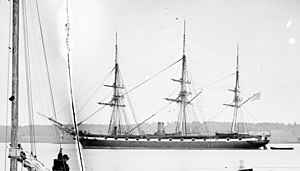
USS Brooklyn was a sloop-of-war authorized by the U.S. Congress and commissioned in 1859. Brooklyn was active in Caribbean operations until the start of the American Civil War at which time she became an active participant in the Union blockade of the Confederate States of America.

USS Minnesota was a wooden steam frigate in the United States Navy. Launched in 1855 and commissioned eighteen months later, the ship served in east Asia for two years before being decommissioned. She was recommissioned at the outbreak of the American Civil War and returned to service as the flagship of the North Atlantic Blockading Squadron.
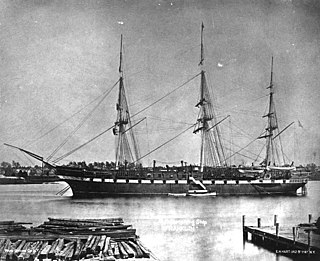
The fourth USS Franklin was a United States Navy screw frigate. The ship was launched in 1864, partially constructed from parts of the previous USS Franklin. Commissioned in 1867, Franklin, named after Founding Father Benjamin Franklin, served as the flagship of the European Squadron from 1867 to 1868 and from 1869 to 1871. She was decommissioned in 1871. Recommissioned in 1873, she joined the North Atlantic Squadron and served until 1877, when she was decommissioned again, then immediately recommissioned for use as a receiving ship at Norfolk, Virginia. She served in this capacity until 1915, when she was stricken and sold.

The first USS Rhode Island was a side-wheel steamer in the United States Navy, commissioned in 1861.

USS Marion was a sloop-of-war of the third rate in the Union Navy during the American Civil War launched at the Boston Navy Yard on 24 April 1839. On 10 November 1839, she departed Boston on her first cruise, to Brazil. Sunk when heaved down in the harbor at Rio de Janeiro early in 1842, she was raised and sailed back to Boston, arriving in May. She then set sail for the Caribbean, returning in May 1843. For the next few years, she remained in ordinary at Boston and then cruised off the West Coast of Africa and in the Mediterranean until 1848. She captured the Casket, a slaver, near Cabinda on 2 August 1846. After a tour in the East Indies from 1850 to 1852, she resumed operations with the African Squadron from 1853 to 1855 and 1858-60, capturing three more slaving ships: Brothers off Mayumba on 8 September 1858 and Orion and Ardennes in late April 1859 off the coast of Kongo. 1856-57 was spent in ordinary at Norfolk.

USS Hartford, a sloop-of-war steamer, was the first ship of the United States Navy named for Hartford, the capital of Connecticut. Hartford served in several prominent campaigns in the American Civil War as the flagship of David G. Farragut, most notably the Battle of Mobile Bay in 1864. She survived until 1956, when she sank awaiting restoration at Norfolk, Virginia.
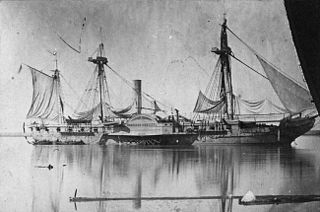
USS Mississippi, a paddle frigate, was the first ship of the United States Navy to bear that name. She was named for the Mississippi River. Her sister ship was Missouri. Her keel was laid down by the Philadelphia Navy Yard in 1839; built under the personal supervision of Commodore Matthew Perry. She was commissioned on 22 December 1841, with Captain W. D. Salter in command and launched several weeks later.
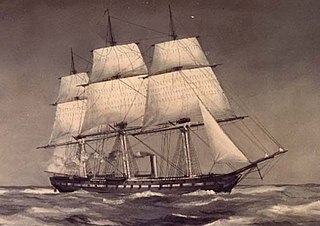
USS Wabash was a steam screw frigate of the United States Navy that served during the American Civil War. She was based on the same plans as Colorado. Post-war she continued to serve her country in European operations and eventually served as a barracks ship in Boston, Massachusetts, and was sold in 1912.

USS Tacony was a double-ended, side-wheel steamboat acquired by the Union Navy during the third year of the American Civil War. She was outfitted as a heavy gunboat with powerful guns and used in the Union blockade of the waterways of the Confederate States of America.
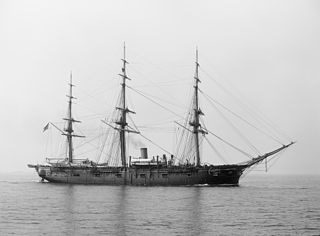
The first USS Lancaster was a screw sloop-of-war in the United States Navy during the American Civil War through the Spanish–American War.

USS Richmond was a wooden steam sloop in the United States Navy during the American Civil War.
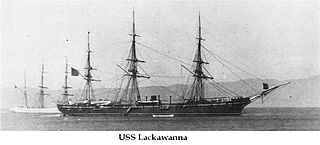
The first USS Lackawanna was a screw-propelled sloop-of-war in the Union Navy during the American Civil War. She was named after the Lackawanna River in Pennsylvania.

The first USS Iroquois was a Mohican-class sloop of war in the United States Navy during the American Civil War.

The first USS Ossipee was a wooden, screw sloop-of-war in commission in the United States Navy at various times between 1861 and 1889. She served in the Union Navy during the American Civil War. She was named for the Ossipee River of New Hampshire and Maine. The USS Ossipee was present during the Alaska Purchase.

The first USS Narragansett was a 2nd class screw sloop in the United States Navy during the American Civil War. Narragansett was built at the Boston Navy Yard, launched on 15 February 1859, and commissioned on 6 November 1859.

The first USS Jamestown was a sloop-of-war in the United States Navy during the Mexican–American War and the American Civil War.
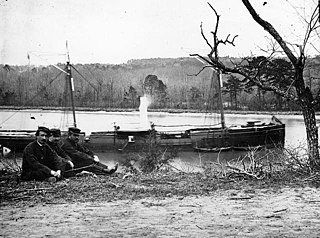
USS Kansas was a gunboat constructed for the Union Navy during the middle of the American Civil War. She was outfitted with heavy guns and assigned to the Union blockade of the waterways of the Confederate States of America. She was the first U.S. Navy ship to be named Kansas and was the first of a class of 836-ton screw steam gunboats. At war's end, she continued serving her country by performing survey work and defending American interests in Cuba until sold in 1883.
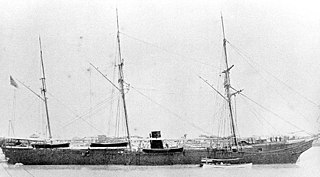
USS Wachusett – the first U.S. Navy ship to be so named – was a large (1,032-ton), Mohican-class steam sloop-of-war that served the United States Navy during the American Civil War. She was outfitted as a gunboat and used by the Navy as part of the Union blockade of the Confederate States of America.
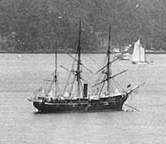
As part of the Secretary of the Navy George M. Robeson's plans to overhaul and modernize ships of the Navy, the first USS Swatara was taken to the New York Navy Yard in 1872, ostensibly for "repairs". In fact, the "repairs" constituted construction of a new ship, for Swatara was given a new hull and unused machinery which had been in storage since 1865. Embodying only certain fittings and equipment from the first ship, the second Swatara was launched on 17 September 1873 at the New York Navy Yard and commissioned on 11 May 1874, Capt. Ralph Chandler in command.

USS Fortune was a steam-powered tugboat that served in the United States Navy intermittently from 1871 to 1922. Built in 1865, she was the first ship so named. Fortune was classified as YT-11 on 17 July 1920. Through her lengthy career, she served as a harbor tug, fireboat, cargo transport, training ship, and submarine tender, among other duties.
